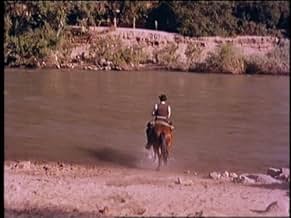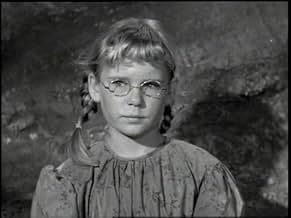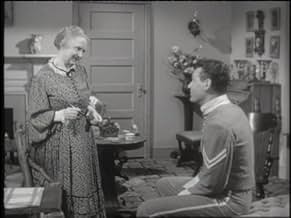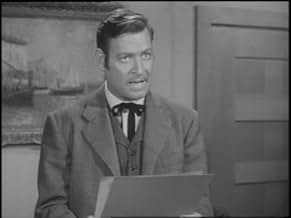Die Abenteuer des maskierten Helden und seines indianischen Partners.Die Abenteuer des maskierten Helden und seines indianischen Partners.Die Abenteuer des maskierten Helden und seines indianischen Partners.
- Für 2 Primetime Emmys nominiert
- 3 Nominierungen insgesamt
Folgen durchsuchen
Empfohlene Bewertungen
10hnsum7
There is only one Lone Ranger and only one Tonto. Clayton Moore and Jay Silverheels. They were both so ingrained in my childhood psyche as hero's, that they remain to this day to be just that. I have watched each and every episode, or at least I believe I have. In doing so it occurred to me that there was never really a gray area, there was right and there was wrong. There was good and there was evil...justice and injustice. Simple, yet powerful messages.
As an adult and watching the earliest episodes, it occurred to me that Tonto, actually gave all the idea's for his partners image. It was Tonto that suggested the mask. It was Tonto that suggested the silver bullets, and it was Tonto that came up with the name for Silver..when he proclaimed that the horse the Lone Ranger saved from death was "Silver White"! At last, as Tonto stood with the lone surviving Ranger over the graves of the others, Tonto, proclaimed "You are all alone now..You Lone Ranger! Of course, the response was "Yes Tonto, I am..The Lone Ranger!
The bonds of friendship and trust for the Lone Ranger and Tonto, was used 25 years later as an example of true friendship in an episode of Happy Days. In this particular episode, where Ritchie wanted to expose Fonzie for hating liver. The remark from Fonzie that typified what a true friendship should be was this "Many people tried to remove the mask of the Lone Ranger, but Tonto "never tried". All of America knew and felt that the truest of friendships would be to be like The Lone Ranger and Tonto.
Clayton Moore and Jay Silverheels are beloved for more than just being actors in a great western that will live forever. They are symbolic of so much more and as I said..will always be my hero's.
As an adult and watching the earliest episodes, it occurred to me that Tonto, actually gave all the idea's for his partners image. It was Tonto that suggested the mask. It was Tonto that suggested the silver bullets, and it was Tonto that came up with the name for Silver..when he proclaimed that the horse the Lone Ranger saved from death was "Silver White"! At last, as Tonto stood with the lone surviving Ranger over the graves of the others, Tonto, proclaimed "You are all alone now..You Lone Ranger! Of course, the response was "Yes Tonto, I am..The Lone Ranger!
The bonds of friendship and trust for the Lone Ranger and Tonto, was used 25 years later as an example of true friendship in an episode of Happy Days. In this particular episode, where Ritchie wanted to expose Fonzie for hating liver. The remark from Fonzie that typified what a true friendship should be was this "Many people tried to remove the mask of the Lone Ranger, but Tonto "never tried". All of America knew and felt that the truest of friendships would be to be like The Lone Ranger and Tonto.
Clayton Moore and Jay Silverheels are beloved for more than just being actors in a great western that will live forever. They are symbolic of so much more and as I said..will always be my hero's.
Iam not sure if discussing the television series is exactly where the comments should be drawn to,however it is on the television where the The Lone Ranger really made a name for himself. Iam not even referring to the original radio broadcasts of this masked rider of the plains,Iam though referring to a point where in a little boy, about 9 or 10 years old,I was to see the movie,"The Lone Ranger"and never forgot it. I can recall that I was on a line or we were moving toward the Paramount Theater-the theater was located in the theater district,if I remember correctly. It was directly across,going East to West from the building that has the ball that drops on New Years Eve-This is of course if anybody doesn't know, New York City. High Above the street on the roof tops there was a time and maybe even still today huge billboards would advertise what was being shown and so on. It was at that point in time that I looked up and was never more impressed as I was when I looked at that billboard to see The Lone Ranger across the roof tops-It was great-It made an impression and was never forgotten. That day we went to see The Lone Ranger-It was the story of how the Lone Ranger was born-The terrible ambush that the Texas Rangers rode into and the subsequent rebirth of one of its fallen heroes. It was in this film we learn that The Lone Ranger will not shoot to kill but to injure so as to let the law be the judge. That type of thinking is so worthwhile that we might be good to learn something from history. This is where we learn that Tonto discovers the fallen Ranger and upon seeing the symbol of the boyhood friendship that The Lone Ranger established years earlier when he as a younger person came to the aide of a injured young person in Tonto-For the aide given, Tonto gave to his faithful friend, a symbol of his thanks which now was part of a necklace that Tonto recognized. Tonto said,"you are Kemosabe". The Lone Ranger said,"kemo-sabe,that is familiar? Then Tonto tells the story of this "trusty scout"(the meaning of Kemosabe)I think the Lone Ranger is one of the true heroes of the silver screen and one of the great heroes of television. It should also be stated that these very respected individuals Clayton Moore and Jay Silverheels sought to live there lives according to the legend of The Lone Ranger-It may very well be that there is an inspiring story in the story of the Lone Ranger and his faithful companion Tonto. I myself was so pleased by the ability to find and buy the DVDs, that I stayed up all a Saturday morning and watched The many episodes now available. Long Live The Lone Ranger and His faithful companion Tonto-Hi-Ho Silver-
There was a time, from my childhood up until the mid-1980's, when shows such as the Lone Ranger and The Little Rascals filled week-day afternoon and Saturday morning TV slots. Old movies could be readily found on TV late at night and on Sunday afternoons. Ever since TV stations began filling every extra additional minute with infomercials and their own first-run productions and reality shows, as well as the beginning of the continuous news cycle, these old classics have not seen the light of day. This shows early years are on DVD, and if you ever get the chance to view the show, do understand that the TV show, at least at first, borrowed heavily from its radio roots.
Also note that some of the first episodes are very short - in some cases only 11 or 12 minutes long. That is because sometimes the sponsor would put two short serials in the same half hour slot. The time really belonged to the sponsor back in those days, and thus early TV schedules looked a lot like radio at first.
One of my favorite episodes was "The Silent Voice" towards the end of season two. The witness to a crime is a stroke victim who is completely paralyzed. The Lone Ranger comes up with a way for the woman to communicate by blinking in response to letters of the alphabet.
The other episode from this early part of the series that sticks out is one in which the wife in a husband/wife crime team betrays the husband and shoots him. He is presumed dead and taken to the undertaker's. The Lone Ranger discovers that the husband is not dead, and the husband makes a confession as to what is going on before he dies as he lies on a slab about to buried - alive. The Lone Ranger tricks the wife by claiming that her husband is still alive. That's what I liked about the Lone Ranger - it really could be very dark. There would always be the happy ending with the criminals rounded up and jailed, but that didn't mean that some good people didn't fall along the way or that something really creepy or cringe-worthy wasn't part of the plot.
Highly recommended if you ever get the chance.
Also note that some of the first episodes are very short - in some cases only 11 or 12 minutes long. That is because sometimes the sponsor would put two short serials in the same half hour slot. The time really belonged to the sponsor back in those days, and thus early TV schedules looked a lot like radio at first.
One of my favorite episodes was "The Silent Voice" towards the end of season two. The witness to a crime is a stroke victim who is completely paralyzed. The Lone Ranger comes up with a way for the woman to communicate by blinking in response to letters of the alphabet.
The other episode from this early part of the series that sticks out is one in which the wife in a husband/wife crime team betrays the husband and shoots him. He is presumed dead and taken to the undertaker's. The Lone Ranger discovers that the husband is not dead, and the husband makes a confession as to what is going on before he dies as he lies on a slab about to buried - alive. The Lone Ranger tricks the wife by claiming that her husband is still alive. That's what I liked about the Lone Ranger - it really could be very dark. There would always be the happy ending with the criminals rounded up and jailed, but that didn't mean that some good people didn't fall along the way or that something really creepy or cringe-worthy wasn't part of the plot.
Highly recommended if you ever get the chance.
Looking back on `The Lone Ranger' TV series as an adult is a strange experience. Watching episodes through an adult's eyes alerted me to flaws I didn't notice when I was a kid: the acting was sometimes on the B-movie level. The stories tended to be repetitive and simplistic. The Native Americans were generally played by Caucasian or Hispanic or Italian-American actors. The `outdoor' exteriors in a lot of episodes were obviously indoor sets. But there is a spirit and an energy to the show that you can't deny.
Most of the credit for the show's success goes to its leads, Clayton Moore and Jay Silverheels. They became the Lone Ranger and Tonto, lived the roles as no other actors before or since. Moore, in particular, knew the Ranger was presented as a hero and an example to children, and from what I've heard, he tried his best to live up to that. He made the Ranger a fair and just man, someone who didn't judge, who gave people the benefit of the doubt, but acted correctly when the time was right. He used violence only as a last resort. He was a symbol of honor and integrity, the kind of person I wish I could be.
As for Tonto... It occurs to me nowadays how great an actor Jay Silverheels was. Critics of the show always want to use Tonto as the stereotypical ignorant savage, but you have to look at all the things Tonto does. Tonto tracks, takes care of the Ranger when he's wounded, spies out information - you can tell from the expressions on Silverheels' face that there's a lot more going on inside Tonto's head than he lets on. Don't let the broken English fool you!
The thing that really impresses me about `The Lone Ranger' now is how much of a partnership these two characters have. Tonto is not the Ranger's subordinate - they are friends, equals in their adventures. That, as much as any lesson taught in any episode, is what draws me back to the series after so many years: a tried and true friendship.
Oh, if only the Lone Ranger could ride again.
Most of the credit for the show's success goes to its leads, Clayton Moore and Jay Silverheels. They became the Lone Ranger and Tonto, lived the roles as no other actors before or since. Moore, in particular, knew the Ranger was presented as a hero and an example to children, and from what I've heard, he tried his best to live up to that. He made the Ranger a fair and just man, someone who didn't judge, who gave people the benefit of the doubt, but acted correctly when the time was right. He used violence only as a last resort. He was a symbol of honor and integrity, the kind of person I wish I could be.
As for Tonto... It occurs to me nowadays how great an actor Jay Silverheels was. Critics of the show always want to use Tonto as the stereotypical ignorant savage, but you have to look at all the things Tonto does. Tonto tracks, takes care of the Ranger when he's wounded, spies out information - you can tell from the expressions on Silverheels' face that there's a lot more going on inside Tonto's head than he lets on. Don't let the broken English fool you!
The thing that really impresses me about `The Lone Ranger' now is how much of a partnership these two characters have. Tonto is not the Ranger's subordinate - they are friends, equals in their adventures. That, as much as any lesson taught in any episode, is what draws me back to the series after so many years: a tried and true friendship.
Oh, if only the Lone Ranger could ride again.
Seriously, while I don't want to be unfair to John Hart, it's impossible for me to watch any of his episodes and not miss Clayton Moore, and I mean miss Clayton Moore badly. It's hard to believe that producer George Trendle really thought he could put anyone in the mask and the public wouldn't know the difference. And the difference was enormous. Clayton Moore played the Lone Ranger with great style and unquestionable sincerity. To me, Clayton Moore' Lone Ranger and William Boyd's Hopalong Cassidy were the best of the early television western heroes. They hold a special place in the hearts of many baby boomers, myself included.
Wusstest du schon
- WissenswertesThe Lone Ranger's young nephew, Dan Reid, who appeared occasionally on this show, was the father of Britt Reid, The Green Hornet. Both characters were created for radio by George W. Trendle.
- PatzerIn the series opening used in syndication, the Lone Ranger is seen riding past rows of trees planted as wind breaks. This practice did not come into use until after the "dust bowl" windstorms of the 1930s.
- Zitate
[first lines for each episode]
Narrator: The Lone Ranger!
[gunshots are fired]
The Lone Ranger: Hi-yo, Silver!
Narrator: A fiery horse with the speed of light, a cloud of dust and a hearty "Hi-yo Silver" - the Lone Ranger!
The Lone Ranger: Hi-yo, Silver, away!
Narrator: With his faithful Indian companion, Tonto, the daring and resourceful masked rider of the plains led the fight for law and order in the early West. Return with us now to those thrilling days of yesteryear. The Lone Ranger rides again!
- Alternative VersionenThe first three episodes are available edited together as a ersatz feature "Enter the Lone Ranger" (1949) running 68 minutes minus titles and recaps.
- VerbindungenEdited into The Legend of the Lone Ranger (1952)
- SoundtracksWilliam Tell Overture: Finale
(uncredited)
Written by Gioachino Rossini
[Played at program opening and during closing credits]
Top-Auswahl
Melde dich zum Bewerten an und greife auf die Watchlist für personalisierte Empfehlungen zu.
- How many seasons does The Lone Ranger have?Powered by Alexa
Details
- Laufzeit30 Minuten
- Seitenverhältnis
- 1.33 : 1
Zu dieser Seite beitragen
Bearbeitung vorschlagen oder fehlenden Inhalt hinzufügen

Oberste Lücke
By what name was The Lone Ranger (1949) officially released in India in English?
Antwort





































